Dvir Samuel
Story2Board: A Training-Free Approach for Expressive Storyboard Generation
Aug 13, 2025Abstract:We present Story2Board, a training-free framework for expressive storyboard generation from natural language. Existing methods narrowly focus on subject identity, overlooking key aspects of visual storytelling such as spatial composition, background evolution, and narrative pacing. To address this, we introduce a lightweight consistency framework composed of two components: Latent Panel Anchoring, which preserves a shared character reference across panels, and Reciprocal Attention Value Mixing, which softly blends visual features between token pairs with strong reciprocal attention. Together, these mechanisms enhance coherence without architectural changes or fine-tuning, enabling state-of-the-art diffusion models to generate visually diverse yet consistent storyboards. To structure generation, we use an off-the-shelf language model to convert free-form stories into grounded panel-level prompts. To evaluate, we propose the Rich Storyboard Benchmark, a suite of open-domain narratives designed to assess layout diversity and background-grounded storytelling, in addition to consistency. We also introduce a new Scene Diversity metric that quantifies spatial and pose variation across storyboards. Our qualitative and quantitative results, as well as a user study, show that Story2Board produces more dynamic, coherent, and narratively engaging storyboards than existing baselines.
Per-Query Visual Concept Learning
Aug 12, 2025Abstract:Visual concept learning, also known as Text-to-image personalization, is the process of teaching new concepts to a pretrained model. This has numerous applications from product placement to entertainment and personalized design. Here we show that many existing methods can be substantially augmented by adding a personalization step that is (1) specific to the prompt and noise seed, and (2) using two loss terms based on the self- and cross- attention, capturing the identity of the personalized concept. Specifically, we leverage PDM features -- previously designed to capture identity -- and show how they can be used to improve personalized semantic similarity. We evaluate the benefit that our method gains on top of six different personalization methods, and several base text-to-image models (both UNet- and DiT-based). We find significant improvements even over previous per-query personalization methods.
Find your Needle: Small Object Image Retrieval via Multi-Object Attention Optimization
Mar 10, 2025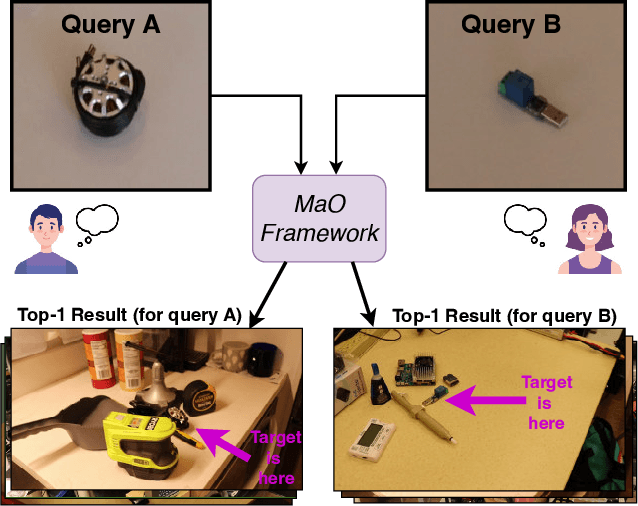
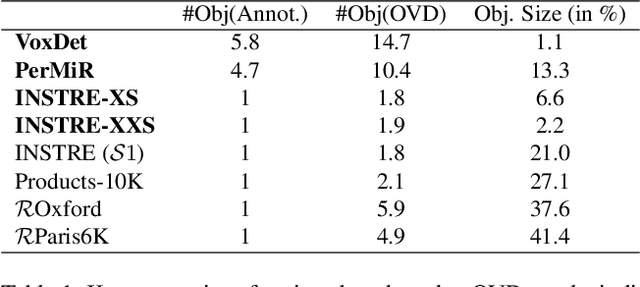
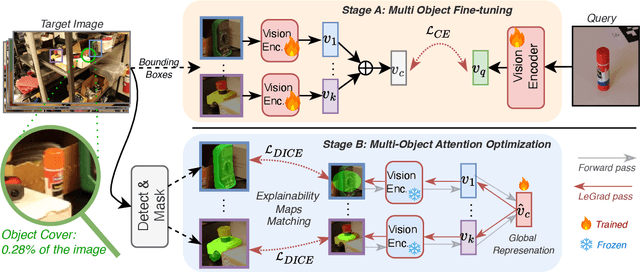
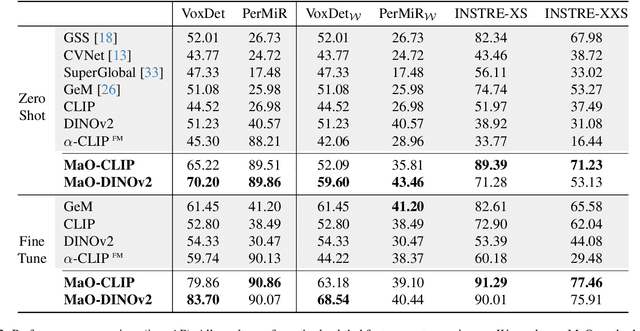
Abstract:We address the challenge of Small Object Image Retrieval (SoIR), where the goal is to retrieve images containing a specific small object, in a cluttered scene. The key challenge in this setting is constructing a single image descriptor, for scalable and efficient search, that effectively represents all objects in the image. In this paper, we first analyze the limitations of existing methods on this challenging task and then introduce new benchmarks to support SoIR evaluation. Next, we introduce Multi-object Attention Optimization (MaO), a novel retrieval framework which incorporates a dedicated multi-object pre-training phase. This is followed by a refinement process that leverages attention-based feature extraction with object masks, integrating them into a single unified image descriptor. Our MaO approach significantly outperforms existing retrieval methods and strong baselines, achieving notable improvements in both zero-shot and lightweight multi-object fine-tuning. We hope this work will lay the groundwork and inspire further research to enhance retrieval performance for this highly practical task.
Task-Specific Adaptation with Restricted Model Access
Feb 02, 2025

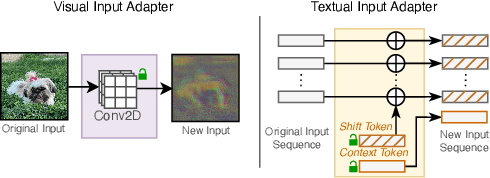
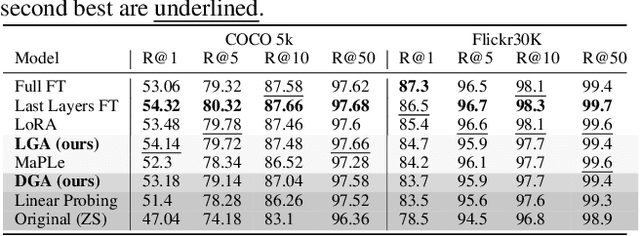
Abstract:The emergence of foundational models has greatly improved performance across various downstream tasks, with fine-tuning often yielding even better results. However, existing fine-tuning approaches typically require access to model weights and layers, leading to challenges such as managing multiple model copies or inference pipelines, inefficiencies in edge device optimization, and concerns over proprietary rights, privacy, and exposure to unsafe model variants. In this paper, we address these challenges by exploring "Gray-box" fine-tuning approaches, where the model's architecture and weights remain hidden, allowing only gradient propagation. We introduce a novel yet simple and effective framework that adapts to new tasks using two lightweight learnable modules at the model's input and output. Additionally, we present a less restrictive variant that offers more entry points into the model, balancing performance with model exposure. We evaluate our approaches across several backbones on benchmarks such as text-image alignment, text-video alignment, and sketch-image alignment. Results show that our Gray-box approaches are competitive with full-access fine-tuning methods, despite having limited access to the model.
Bringing Objects to Life: 4D generation from 3D objects
Dec 29, 2024Abstract:Recent advancements in generative modeling now enable the creation of 4D content (moving 3D objects) controlled with text prompts. 4D generation has large potential in applications like virtual worlds, media, and gaming, but existing methods provide limited control over the appearance and geometry of generated content. In this work, we introduce a method for animating user-provided 3D objects by conditioning on textual prompts to guide 4D generation, enabling custom animations while maintaining the identity of the original object. We first convert a 3D mesh into a ``static" 4D Neural Radiance Field (NeRF) that preserves the visual attributes of the input object. Then, we animate the object using an Image-to-Video diffusion model driven by text. To improve motion realism, we introduce an incremental viewpoint selection protocol for sampling perspectives to promote lifelike movement and a masked Score Distillation Sampling (SDS) loss, which leverages attention maps to focus optimization on relevant regions. We evaluate our model in terms of temporal coherence, prompt adherence, and visual fidelity and find that our method outperforms baselines that are based on other approaches, achieving up to threefold improvements in identity preservation measured using LPIPS scores, and effectively balancing visual quality with dynamic content.
Add-it: Training-Free Object Insertion in Images With Pretrained Diffusion Models
Nov 12, 2024
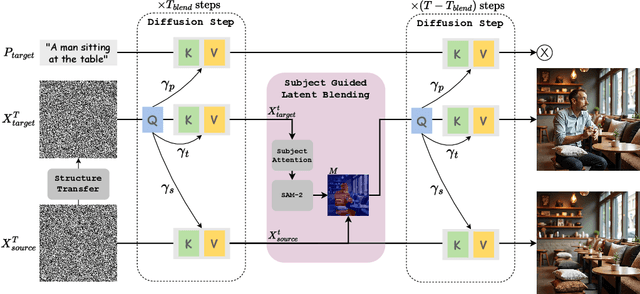

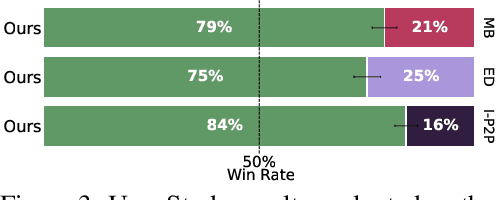
Abstract:Adding Object into images based on text instructions is a challenging task in semantic image editing, requiring a balance between preserving the original scene and seamlessly integrating the new object in a fitting location. Despite extensive efforts, existing models often struggle with this balance, particularly with finding a natural location for adding an object in complex scenes. We introduce Add-it, a training-free approach that extends diffusion models' attention mechanisms to incorporate information from three key sources: the scene image, the text prompt, and the generated image itself. Our weighted extended-attention mechanism maintains structural consistency and fine details while ensuring natural object placement. Without task-specific fine-tuning, Add-it achieves state-of-the-art results on both real and generated image insertion benchmarks, including our newly constructed "Additing Affordance Benchmark" for evaluating object placement plausibility, outperforming supervised methods. Human evaluations show that Add-it is preferred in over 80% of cases, and it also demonstrates improvements in various automated metrics.
Unveiling the Power of Diffusion Features For Personalized Segmentation and Retrieval
May 28, 2024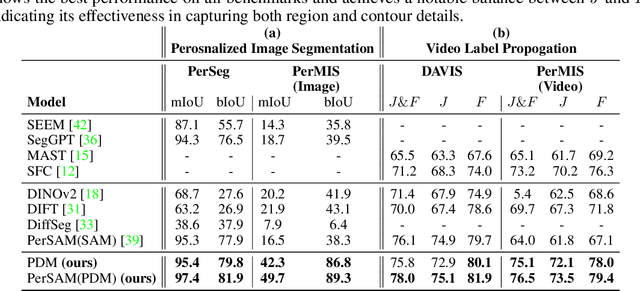

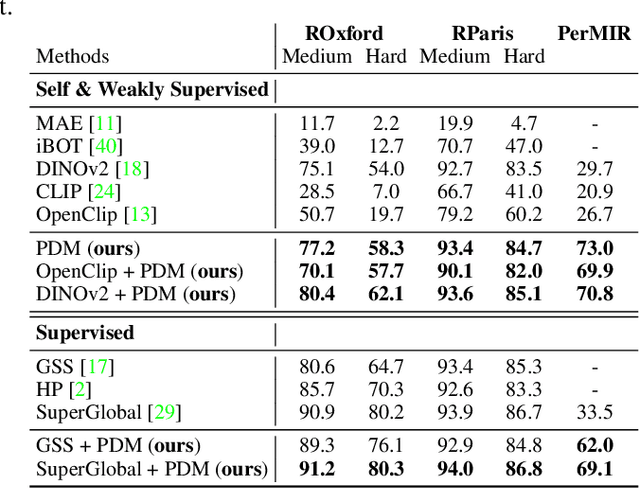
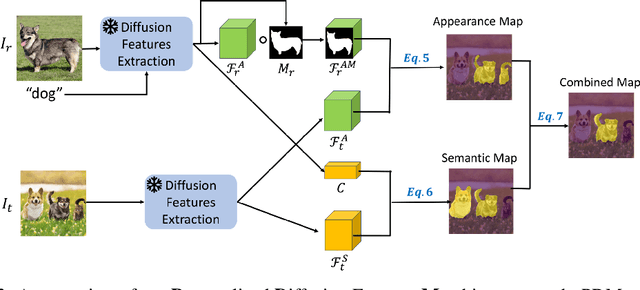
Abstract:Personalized retrieval and segmentation aim to locate specific instances within a dataset based on an input image and a short description of the reference instance. While supervised methods are effective, they require extensive labeled data for training. Recently, self-supervised foundation models have been introduced to these tasks showing comparable results to supervised methods. However, a significant flaw in these models is evident: they struggle to locate a desired instance when other instances within the same class are presented. In this paper, we explore text-to-image diffusion models for these tasks. Specifically, we propose a novel approach called PDM for Personalized Features Diffusion Matching, that leverages intermediate features of pre-trained text-to-image models for personalization tasks without any additional training. PDM demonstrates superior performance on popular retrieval and segmentation benchmarks, outperforming even supervised methods. We also highlight notable shortcomings in current instance and segmentation datasets and propose new benchmarks for these tasks.
EffoVPR: Effective Foundation Model Utilization for Visual Place Recognition
May 28, 2024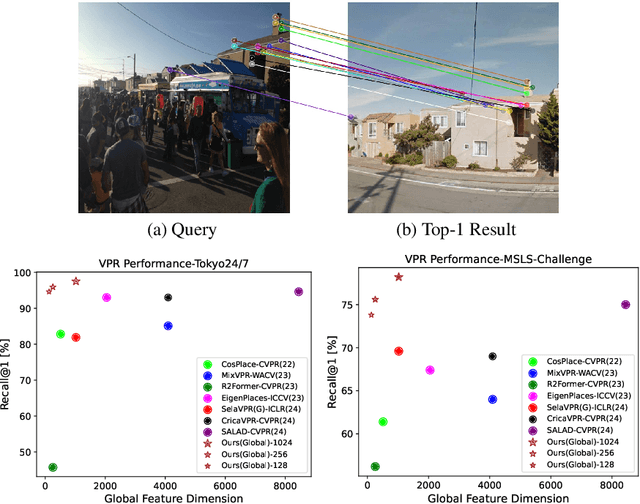
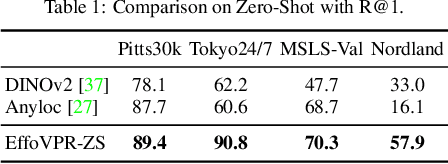
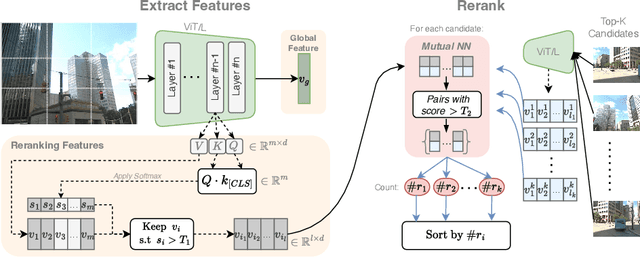
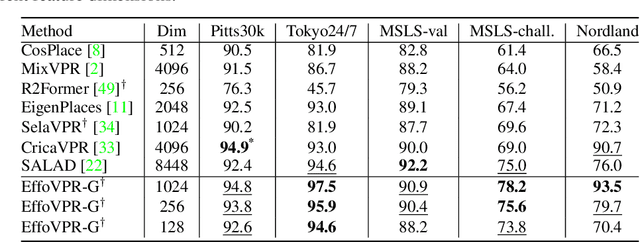
Abstract:The task of Visual Place Recognition (VPR) is to predict the location of a query image from a database of geo-tagged images. Recent studies in VPR have highlighted the significant advantage of employing pre-trained foundation models like DINOv2 for the VPR task. However, these models are often deemed inadequate for VPR without further fine-tuning on task-specific data. In this paper, we propose a simple yet powerful approach to better exploit the potential of a foundation model for VPR. We first demonstrate that features extracted from self-attention layers can serve as a powerful re-ranker for VPR. Utilizing these features in a zero-shot manner, our method surpasses previous zero-shot methods and achieves competitive results compared to supervised methods across multiple datasets. Subsequently, we demonstrate that a single-stage method leveraging internal ViT layers for pooling can generate global features that achieve state-of-the-art results, even when reduced to a dimensionality as low as 128D. Nevertheless, incorporating our local foundation features for re-ranking, expands this gap. Our approach further demonstrates remarkable robustness and generalization, achieving state-of-the-art results, with a significant gap, in challenging scenarios, involving occlusion, day-night variations, and seasonal changes.
Fixed-point Inversion for Text-to-image diffusion models
Dec 19, 2023
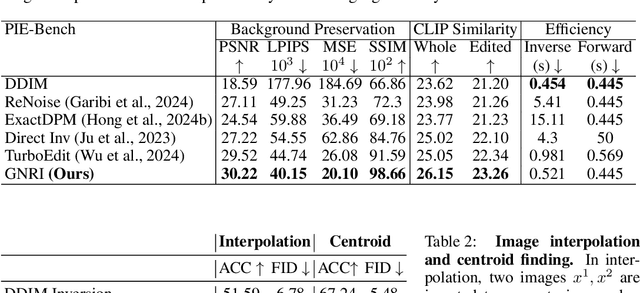


Abstract:Text-guided diffusion models offer powerful new ways to generate and manipulate images. Several applications of these models, including image editing interpolation, and semantic augmentation, require diffusion inversion. This is the process of finding a noise seed that can be used to generate a given image. Current techniques for inverting a given image can be slow or inaccurate. The technical challenge for inverting the diffusion process arises from an implicit equation over the latent that cannot be solved in closed form. Previous approaches proposed to solve this issue by approximation or various learning schemes. Here, we formulate the problem as a fixed-point equation problem and solve it using fixed-point iterations, a well-studied approach in numerical analysis. We further identify a source of inconsistency that significantly hurts the inversion of real images encoded to the latent space. We show how to correct it by applying a prompt-aware adjustment of the encoding. Our solution, Fixed-point inversion, is much faster than previous techniques like EDICT and Null-text, with similar inversion quality. It can be combined with any pretrained diffusion model and requires no model training, prompt tuning, or additional parameters. In a series of experiments, we find that Fixed-point inversion shows improved results in several downstream tasks: image editing, image interpolation, and generation of rare objects.
Norm-guided latent space exploration for text-to-image generation
Jun 14, 2023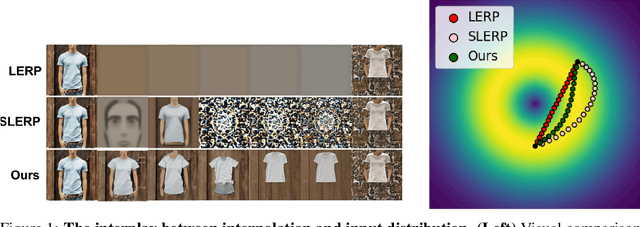
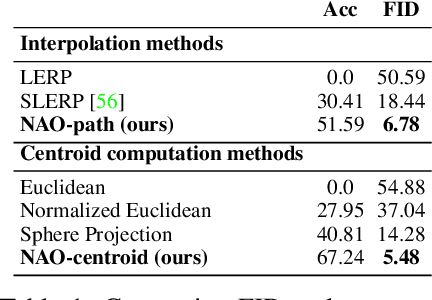
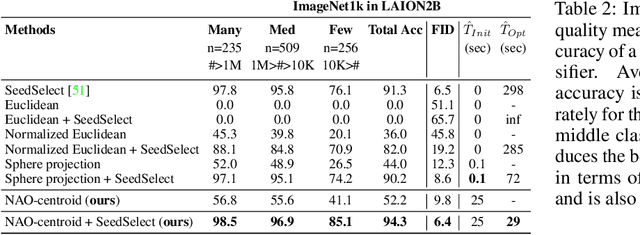

Abstract:Text-to-image diffusion models show great potential in synthesizing a large variety of concepts in new compositions and scenarios. However, their latent seed space is still not well understood and has been shown to have an impact in generating new and rare concepts. Specifically, simple operations like interpolation and centroid finding work poorly with the standard Euclidean and spherical metrics in the latent space. This paper makes the observation that current training procedures make diffusion models biased toward inputs with a narrow range of norm values. This has strong implications for methods that rely on seed manipulation for image generation that can be further applied to few-shot and long-tail learning tasks. To address this issue, we propose a novel method for interpolating between two seeds and demonstrate that it defines a new non-Euclidean metric that takes into account a norm-based prior on seeds. We describe a simple yet efficient algorithm for approximating this metric and use it to further define centroids in the latent seed space. We show that our new interpolation and centroid evaluation techniques significantly enhance the generation of rare concept images. This further leads to state-of-the-art performance on few-shot and long-tail benchmarks, improving prior approach in terms of generation speed, image quality, and semantic content.
 Add to Chrome
Add to Chrome Add to Firefox
Add to Firefox Add to Edge
Add to Edge